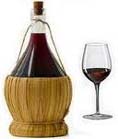Cruet Sets
from Italian Traditional Food
General information on cruet
sets
Check out these great Italian ideas at Amazon for Italian food and kitchen ideas.
Collecting cruet sets
Collecting cruet sets can be fun and interesting, too. Collecting items of
tableware on a limited budget has its problems, but it's worth considering such things as mustard pots, cruet
bottles and sugar casters. These often have silver tops and seem to be classified as neither strictly silver nor
glassware. As such cruet sets are often passed over by the more specialised
investor and are not usually expensive. Even a late Victorian or Edwardian cruet set, with it's cut or moulded
glass bottles and metal stand of handsome proportions, can lend dignity to a modern table.
"Diamond cruets" were advertised by George Ravenscroft as early as 1677, but these were merely
glass bottles with loosely fitting silver tops, used for oil and vinegar and selling for the princely sum of two
shillings each.
They bore little relation to the magnificent cruet sets, holding
bottles for oil, vinegar, sugar, salt, two kinds of pepper and a mustard pot, created during the first twenty years
of the 19th century.
From about 1765, fashion dictated that the silver casters for pepper and sugar - salt still had
its separate cellar- as well as the glass bottles for vinegar and oil, should be replaced by matching, pear-shaped
containers made of opaque, white glass. These were often richly decorated with enamels, and their success prompted
silversmiths to replace their erstwhile silver casters with completely matching sets of mounted glass.
Muffineers
Some of those little cut-glass "dredgers" that look like pepper pots with metal tops may turn
out to be "muffineers", used towards the end of the 18th century for sprinkling cinnamon on the hot buttered
muffins bought from the street vendor for afternoon tea. Look out, too, for standish bottles. These look like
small, squat cruet jars, but have fewer, larger holes in the silver tops. They come from inkstands and were meant
for the desk and not the table.
Then there are the smaller pieces of pierced silverware - salt cellars, mustard pots and even
sugar bowls - popular throughout the Georgian era. These are punched with ever more elaborate lattice-work patterns
and contain liners of rich, deep "Bristol" blue glass which contrast happily with the polished silver fretwork.
Later copies, of nickel plate, were made in the same, pleasing style, and are worth finding. Trust that you enjoyed
this short article on cruets sets.
Read more Italian traditional food related articles here

Copyright © 2009 - . All Rights Reserved
Worldwide. Italian Traditional Food
You may not reprint articles from this website
without the written permission of the site owner.
Disclaimer: Articles on this
Website are provided for information purposes only. Italiantraditionalfood.com does not accept any responsibility
or liability for the use or misuse of the article content on this site or reliance by any person on the site's
contents.
| 


 Digg
Digg Stumbleupon
Stumbleupon Google Bookmarks
Google Bookmarks Delicious
Delicious Twitter
Twitter Facebook
Facebook Yahoo My Web
Yahoo My Web Reddit
Reddit